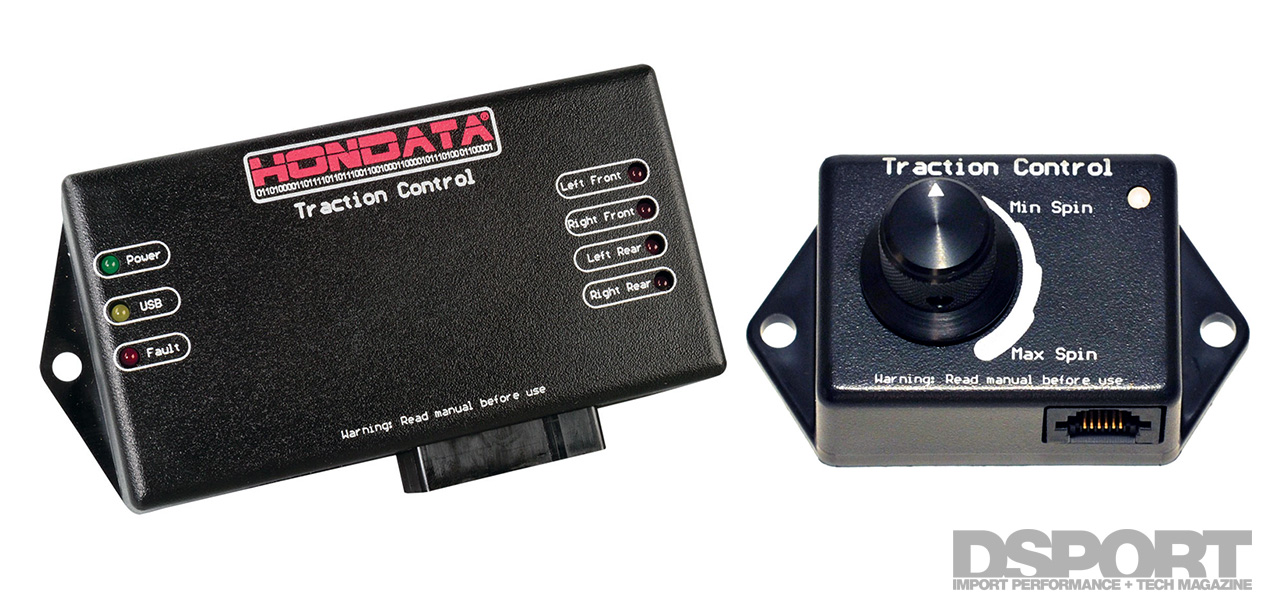A split second can make the difference between winning and losing a race. A loss of traction is often the cause of those split second differences in performance. Hondata Inc. has studied traction issues experienced by drag racers, road racers, land speed racers and even the daily driver in their quest to put more Hondata-equipped cars in the winner’s circle. What started as a pet project developed into a new product solution thanks to a four-year development effort.
Text and Photos by Richard Fong
Interference
[pullquote]PARTIALLY ACTIVE SYSTEMS TEND TO INHIBIT PERFORMANCE DRIVING[/pullquote]Factory stability control and traction control systems employ the ABS sensors among other factory-installed sensors to detect variances in wheel speeds and steering angle. The system then applies brake pressure to each tire individually to stabilize the vehicle and preempt loss of control. However, these systems do not offer adjustable levels of control and often hinder high-performance driving. Some systems can be turned completely off but others can only be partially deactivated, remaining semi-operational in the background. Partially-active systems also tend to inhibit performance driving.
Putting ABS Sensors To Work
Like the factory systems, the Hondata Traction Control (HTC) system utilizes the factory ABS sensors to detect excessive wheel spin. Designed for front- and rear-wheel drive platforms, the HTC system monitors and detects a measurable difference between the driven and undriven wheels. It then commands the ECU to reduce power by way of the ignition system to reduce power until the targeted amount of wheel slip is achieved.
Traction Controls
 The Hondata Traction Control system includes the HTC module, a six-position switch and a flying lead harness. The six-position switch features five user-programmable levels of intervention and an off position.
The Hondata Traction Control system includes the HTC module, a six-position switch and a flying lead harness. The six-position switch features five user-programmable levels of intervention and an off position.
Currently designed as a complement to Hondata’s s300, KPro and FlashPro engine management solutions, it is possible to adapt the traction control unit to work with any engine management system with a 5-volt auxiliary input. If the vehicle does not have an ABS system, installing ABS sensors is a must.
Turning Slip Into Grip
With the hardware in place, the next step is to set up the software. The default settings offer uniformly spaced wheel slip target percentages front-to-rear (for straight-line traction) as well as left-to-right (for cornering) for each of the five switch positions.

 By way of a USB cable and a Windows-based operating system, the HTC module’s five control settings can be customized from the default settings using Hondata’s traction control software. The slip target percentages can be adjusted to the user’s preference for both straight-line and cornering so that on-the-fly adjustments can be made.
By way of a USB cable and a Windows-based operating system, the HTC module’s five control settings can be customized from the default settings using Hondata’s traction control software. The slip target percentages can be adjusted to the user’s preference for both straight-line and cornering so that on-the-fly adjustments can be made.
Testing The Limits
 On paper, the HTC system made sense. However, the real test would be an on-track evaluation under both dry and wet conditions. Hondata invited us to its Traction Control test session at The Streets of Willow in Rosamond, California.
On paper, the HTC system made sense. However, the real test would be an on-track evaluation under both dry and wet conditions. Hondata invited us to its Traction Control test session at The Streets of Willow in Rosamond, California.
Several test vehicles equipped with the device included a couple of supercharged Honda Civics, a supercharged Honda S2000, a turbocharged S2000, a supercharged Acura TSX and an RSX. Each of these vehicles was equipped with an HTC unit programmed to the default settings.







